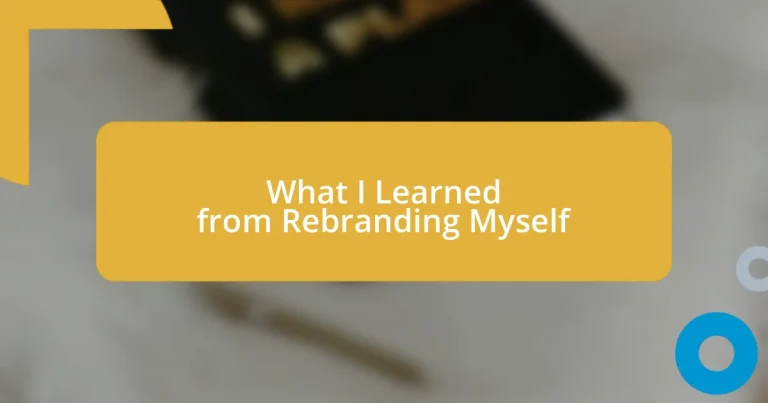Key takeaways:
- Personal branding is a dynamic, evolving process that reflects your authentic self, values, and unique experiences.
- Self-reflection is crucial for identifying true motivations and aligning your branding with personal values, enabling deeper connections with others.
- Effective engagement with your audience involves storytelling and community interaction, fostering genuine connections and feedback for continuous growth.
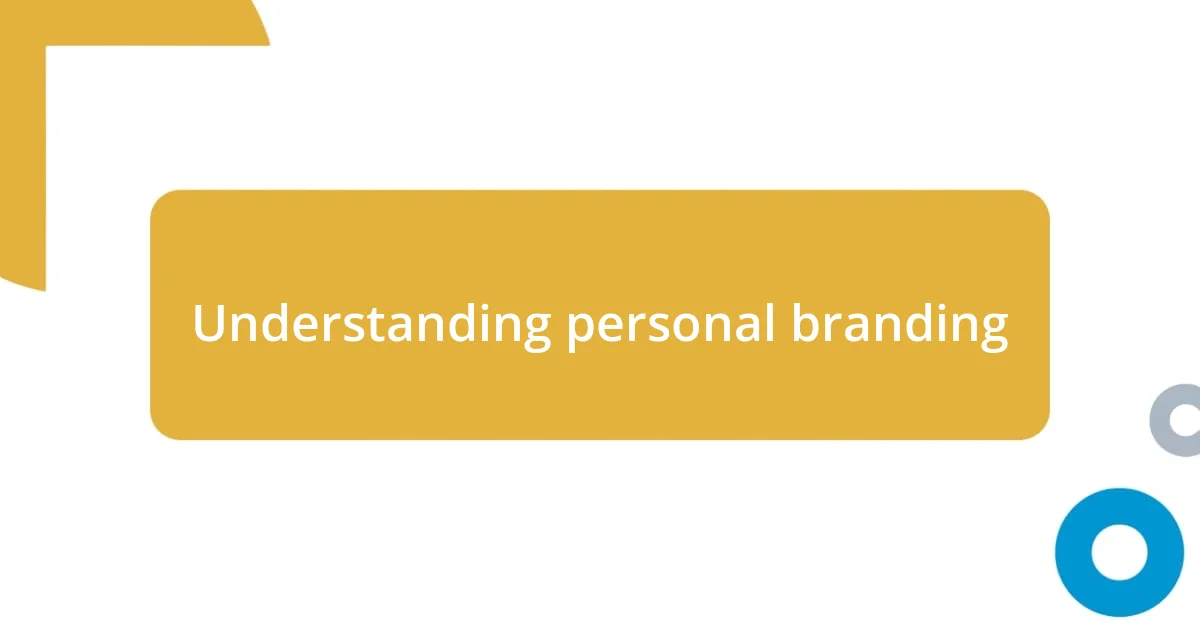
Understanding personal branding
Personal branding is more than just a neat logo or catchy tagline; it’s the essence of who you are and how others perceive you. I remember when I first began to realize that my online presence didn’t align with my true self. Have you ever felt like your authentic voice was muffled by expectations? It took some reflection to understand that my brand needed to authentically reflect my values and passions.
As I delved deeper into personal branding, I discovered it’s about crafting a narrative that resonates with others. I once participated in an event where I shared my journey and unexpectedly noticed how powerful my story was in connecting with people. That moment made me think—how often do we overlook our unique experiences as part of our brand? Your story can be a bridge to others, creating connections that matter.
Moreover, personal branding requires ongoing self-assessment and adaptability. I realized that as I evolved, so too did my brand. Have you ever felt stuck, puzzled about how to convey a changing identity? Embracing the idea that personal branding is a dynamic process can be liberating. It allows you to grow and shift, ensuring your brand remains a true reflection of who you are at any given moment.

The importance of self-reflection
Self-reflection is the cornerstone of any meaningful change. I remember sitting in my favorite café, sipping on a latte, when it hit me—how could I truly evolve my brand without understanding my own motivations and desires? This quiet moment of contemplation allowed me to peel back layers I didn’t even realize I had. I found that self-reflection not only brings clarity but also ignites passion and authenticity in your personal story.
- It helps identify your true values and priorities.
- Self-reflection unveils blind spots in your branding.
- I often revisited journals, and the insights I gleaned unleashed this vibrant energy I hadn’t tapped into before.
- It fosters resilience by helping you learn from past experiences and missteps.
- This process is not just about personal growth; it connects you more deeply with those who resonate with your authentic self.
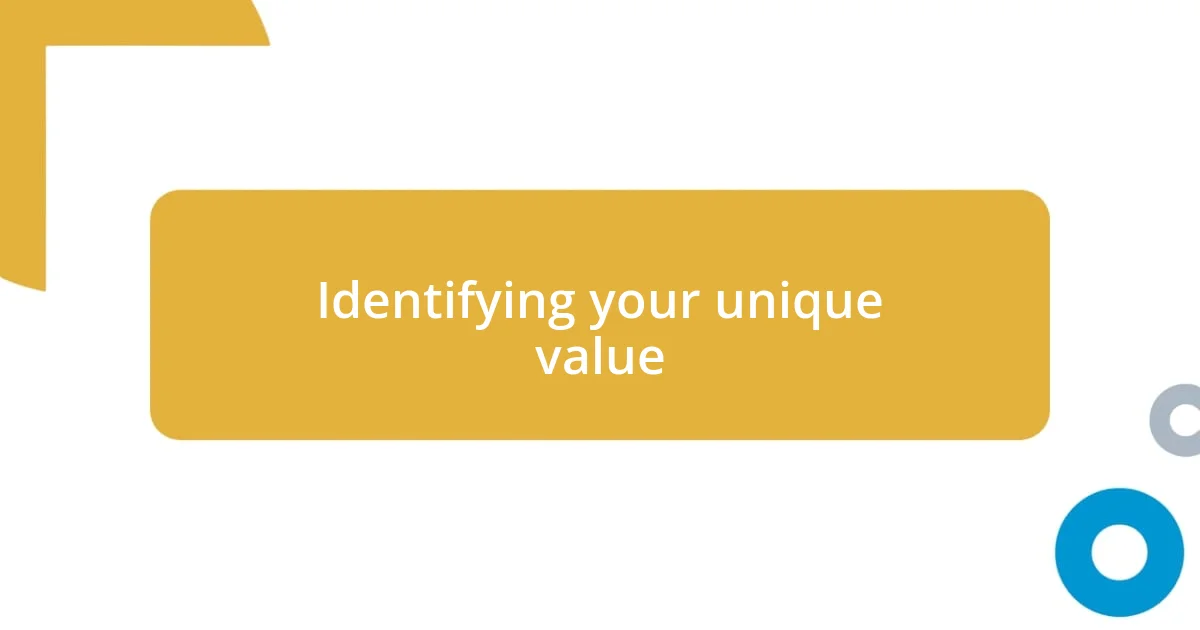
Identifying your unique value
Identifying your unique value can be a transformative journey. I remember when I first sat down to map out what truly set me apart. Initially, it felt daunting, like staring at a blank canvas. I started with asking myself simple questions: What skills do I possess? What experiences make me unique? Each answer revealed a piece of the puzzle, unveiling characteristics I often underrated. This process made me realize that my unique value isn’t just about professional skills—it’s about the blend of my personality, experiences, and even my quirks that contribute to my authenticity.
As I worked through this exercise, I reflected on moments from my past that shaped my perspective. For instance, volunteering at a local shelter taught me empathy in a way that no classroom ever could. This experience added depth to my understanding of social issues and influenced how I communicate my brand, enriching my narrative. It’s often the seemingly small experiences that crystallize what makes us special. I found that identifying my unique value wasn’t merely about listing accomplishments, but about understanding the stories behind them—stories that resonate with others.
To truly communicate your unique value, balance self-awareness with external feedback. Conversations with friends and colleagues provided insights I might have overlooked. I asked them, “What do you think I excel at?” Their perspectives often highlighted strengths I didn’t recognize within myself. This collaborative effort not only enriched my understanding but also helped me convey my value in a way that feels more authentic and relatable.
| Unique Value Identification | Notes |
|---|---|
| Skills and Experiences | List professional and personal experiences that make you stand out. |
| Anecdotes and Insights | Draw upon specific stories that showcase your unique strengths. |
| Feedback | Engage others in conversations to uncover strengths you may overlook. |

Crafting a compelling narrative
Crafting a compelling narrative is about weaving together the threads of your experiences, values, and aspirations into a tapestry that reflects your true self. I recall the moment I decided to share my journey of overcoming obstacles in my life. I had faced challenges that felt insurmountable, but connecting these struggles to my growth allowed me to create a narrative that resonated deeply with others. Each story added a layer to my narrative, turning vulnerability into strength and fostering a sense of authenticity that others could connect with.
I found that the most impactful narratives are those infused with genuine emotion. For instance, as I crafted my story, I remembered the overwhelming sense of joy I felt the day I completed my first marathon. It wasn’t just about crossing the finish line; it was about the months of perseverance, the moments of doubt, and the support from friends and family along the way. This experience taught me how emotional highs and lows can transform a simple story into a rich narrative that not only captures attention but also builds a connection with the audience. Have you ever shared a moment that left you feeling raw yet empowered? That’s where the real power lies.
Additionally, I discovered the importance of aligning your narrative with your core values. As I reflected on my journey, it became clear that honesty and empathy were my guiding principles. This clarity pushed me to infuse these values into my storytelling. When I started speaking about my efforts to mentor others, I realized that it wasn’t just a bullet point on my resume; it was a testament to my commitment to fostering growth in others. Isn’t it fascinating how sharing your values as part of your narrative can create a shared experience with your audience? It feels like an invitation for them to join you on your journey.
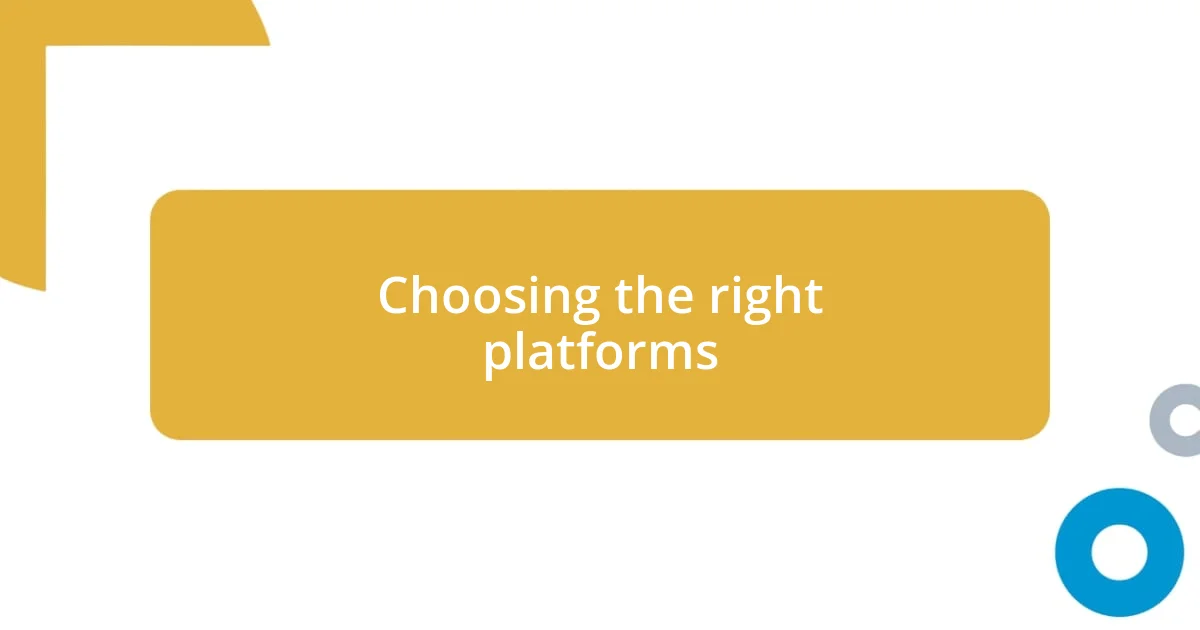
Choosing the right platforms
Choosing the right platforms was a pivotal part of my rebranding journey. I recall spending hours sifting through social media options, considering where my target audience hung out the most. Initially, I was tempted to create profiles everywhere, but I realized that spreading myself too thin dilutes my message. Instead, I narrowed my focus to platforms that aligned with my values and where I felt I could genuinely engage with people—primarily LinkedIn and Instagram.
It’s surprising how much a thoughtful platform choice can influence your connection with others. For example, when I started sharing insights on LinkedIn, I was met with engagement from industry peers who appreciated my professional take. Conversely, my attempts at a more casual approach on TikTok didn’t resonate because it felt out of sync with my authentic self. Have you ever tried to fit into a space that didn’t feel right? It can feel exhausting and eventually leaves you questioning your brand.
As I gained clarity on my chosen platforms, I also learned about the importance of content type. Understanding how different platforms cater to various styles—like the visual nature of Instagram versus the professional tone of LinkedIn—helped me tailor my messaging. I remember feeling a rush of excitement when my Instagram stories incorporated snippets of my journey living authentically; it thrilled me to see the conversations it sparked among my peers. Selecting the right platforms not only allows you to showcase your unique value but also creates the opportunity for genuine interactions and growth.

Engaging with your audience
Engaging with your audience became a transformative experience for me. I still remember the excitement of hosting a live Q&A session. Watching the comments roll in made me realize how eager people were to connect. It wasn’t just about sharing information; it was about fostering a community where everyone felt their voices mattered. Have you ever felt that thrill when you engage directly with your audience? It’s a unique energy that’s hard to replicate.
I soon discovered that asking questions is a powerful tool for engagement. During one session, I posed a simple yet thought-provoking question: “What does authenticity mean to you?” The responses poured in, revealing diverse perspectives that enriched the conversation. It reminded me that while I shared my journey, I’m also learning from others. Isn’t it fascinating how opening up can lead to such meaningful dialogues?
Another insight I gained was the significance of storytelling in engagement. One night, I decided to share a personal tale about a setback that nearly derailed my ambitions. As I spoke, I noticed how my vulnerability opened the floor for others to share their experiences, creating a sense of solidarity. I realized that engaging with your audience isn’t merely about speaking at them—it’s about creating a space for shared experiences. How do you create connections while sharing your journey? It’s about authenticity, storytelling, and the willingness to listen.
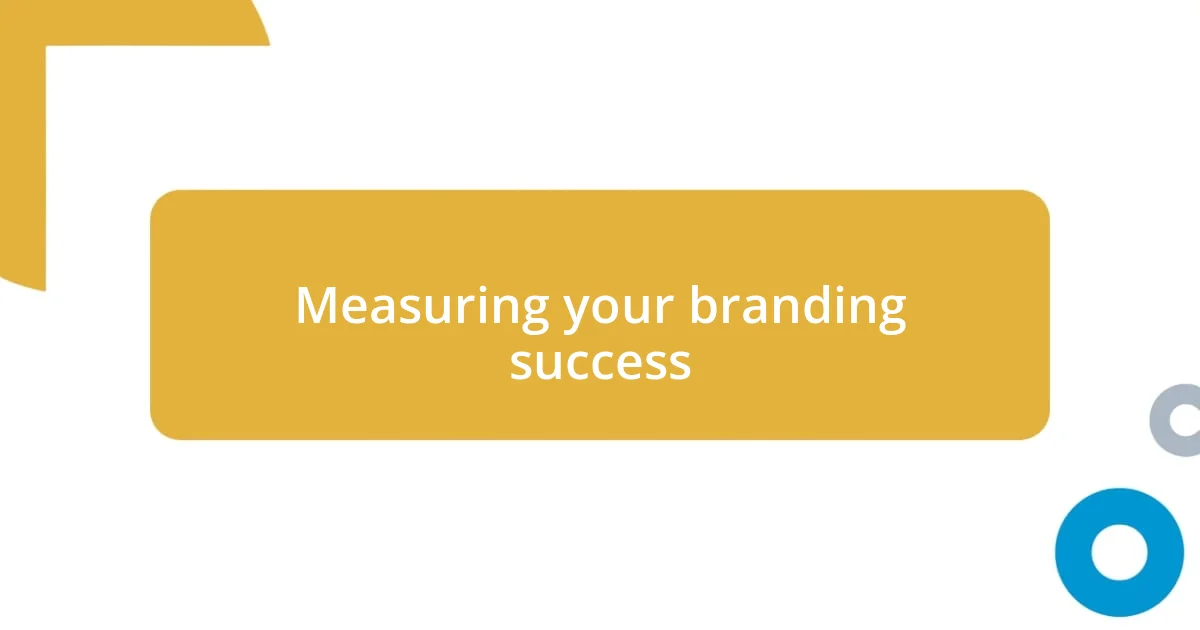
Measuring your branding success
Measuring branding success can feel a bit like trying to catch smoke with your bare hands; it’s not always straightforward. I found that using specific metrics, like engagement rates and follower growth, helps transform that intangible feeling into something tangible. I remember when I first set up analytics; it was eye-opening to see how my content resonated with different segments of my audience. Ever tracked a post that performed better than you expected? The thrill of discovery is hard to beat.
Another essential measure for me was tracking how my brand aligned with my core values. I’d regularly reflect on whether my interactions and content truly mirrored who I am. I recall a period when I strayed too far from my mission, chasing trends instead of authenticity. The feedback was immediate—my audience noticed. It taught me that authenticity isn’t just a buzzword; it’s the cornerstone of meaningful branding.
I also started conducting surveys to gather direct feedback from my community. One time, I asked followers what they loved most about my content. The responses were not only affirming but also highlighted areas for growth that I hadn’t considered. Have you ever asked for feedback and been surprised by what you learned? It’s a simple but profound way to fine-tune your approach and ensure your brand continues to evolve with those you aim to serve.












